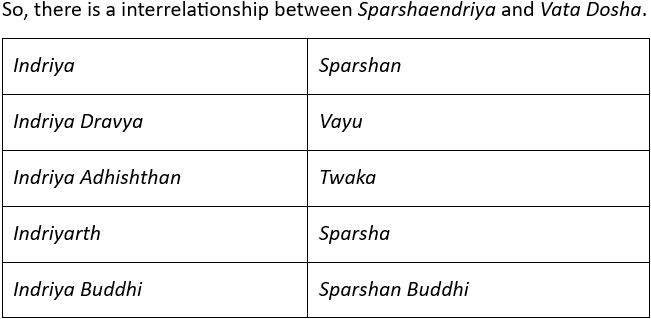Twacha, Vata and Mann: An Ayurvedic Approach to Psychodermatology
DOI:
https://doi.org/10.21760/jaims.10.7.19Keywords:
Beauty, Skin care, Spiritual therapy, Mann (mind), YogaAbstract
Introduction: In Ayurveda, Twak Vikar (Skin Disease) encompasses all pathological conditions affecting the skin physiology and anatomy, reflecting the body's and mind's state. The skin is influenced by psychological factors impacting quality of life. Aacharya Charak emphasizes the connection between Twacha (skin) and Mann (mind), suggesting psychological involvement in dermatological disorders. This study explores how imbalances in Vata can impact both skin health and mental well-being, with an emphasis on the therapeutic benefits of Yoga, meditation and counselling. Aim and Objective: To explore the relationship between Twacha, Vata, and Mann and explain the Ayurvedic approach to Psychodermatology. Methods: A review of Ayurvedic texts and contemporary science to understand the relationship between Vata Dosha imbalances, skin conditions and mental health. The effectiveness of Yoga, meditation and counselling in balancing Vata and improving skin conditions. Discussion: Psychodermatology combines psychological and psychiatric treatments to treat skin problems. Psychodermatology studies the relationship between mind and skin. Psychiatry focuses on internal, non-visible diseases, whereas dermatology focuses on external visible disease. The Ayurvedic approach to Twak Vikar involves both pharmacological and non-pharmacological treatments, with an emphasis on Vata Dosha balance and calmness of Mann. The link between Sparshnendriya, Mann, and Vata promotes a complete treatment strategy for skin problems. Conclusion: Ayurveda recognizes a strong link between Mann, Twacha, and Vata Dosha. Vata imbalances can cause skin problems as well as have an impact on mental health. Addressing these imbalances through techniques such as Yoga, Meditation and Counselling therapy benefits both skin health and psychological well-being, emphasizing the necessity of a comprehensive approach to treating dermatological problems.
Downloads
References
Shastri PK, Chaturvedi G. Charaka Samhita (Vidyotini Hindi Commentary). Varanasi: Chowkhambha Sanskrit Sansthan; 2017. Sutrasthana, Ch.11, v.38. p.230.
Shastri PK, Chaturvedi G. Charaka Samhita (Vidyotini Hindi Commentary). Varanasi: Chowkhambha Sanskrit Sansthan; 2017. Sutrasthana, Ch.11, v.38. p.230.
Shastri PK, Chaturvedi G. Charaka Samhita (Vidyotini Hindi Commentary). Varanasi: Chowkhambha Sanskrit Sansthan; 2017. Sharirsthana, Ch.1, v.19. p.804.
Duplicate of reference 2 — retain only once if cited identically.
Shastri PK, Chaturvedi G. Charaka Samhita (Vidyotini Hindi Commentary). Varanasi: Chowkhambha Sanskrit Sansthan; 2017. Sharirsthana, Ch.1, v.75–76. p.818.
Shastri PK, Chaturvedi G. Charaka Samhita (Vidyotini Hindi Commentary). Varanasi: Chowkhambha Sanskrit Sansthan; 2017. Sutrasthana, Ch.8, v.4 & v.7. p.173 & 176.
Shastri PK, Chaturvedi G. Charaka Samhita (Vidyotini Hindi Commentary). Varanasi: Chowkhambha Sanskrit Sansthan; 2017. Sharirsthana, Ch.1, v.79. p.819.
Shastri PK, Chaturvedi G. Charaka Samhita (Vidyotini Hindi Commentary). Varanasi: Chowkhambha Sanskrit Sansthan; 2017. Sutrasthana, Ch.8, v.9–12. p.177.
Shastri PK, Chaturvedi G. Charaka Samhita (Vidyotini Hindi Commentary). Varanasi: Chowkhambha Sanskrit Sansthan; 2017. Sutrasthana, Ch.12, v.7. p.246.
Shastri PK, Chaturvedi G. Charaka Samhita (Vidyotini Hindi Commentary). Varanasi: Chowkhambha Sanskrit Sansthan; 2017. Sutrasthana, Ch.12, v.7. p.246.
Shastri PK, Chaturvedi G. Charaka Samhita (Vidyotini Hindi Commentary). Varanasi: Chowkhambha Sanskrit Sansthan; 2021. Chikitsasthana, Ch.3, v.115. p.111.
Jafferany M. Psychodermatology: a guide to understanding common psychocutaneous disorders. Prim Care Companion J Clin Psychiatry. 2007;9(3):203–13. doi:10.4088/pcc.v09n0306. PMID: 17632653; PMCID: PMC1911167.















